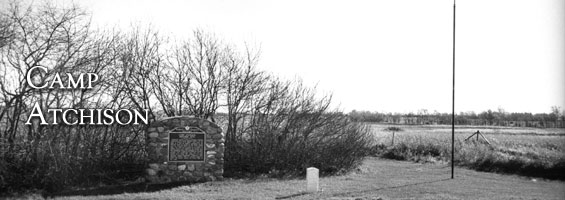We’ve launched a new web portal! Visit findhistory.nd.gov to search our collections.
Due to a road closure, the Killdeer Mountain Battlefield State Historic Site is temporarily closed.

Camp Atchison, two and one-half miles south of Binford, Griggs County, served as a major base camp and landmark for the 1863 Sibley expedition. Prior to July 17, the principal thrust of the expedition had been toward Devils Lake where alleged Indian participants of the Dakota Conflict of 1862 were rumored to be living. On July 17, however, friendly Chippewa Indians visited General Sibley at Camp Pope and told him that the people he was pursuing had left the Devils Lake area and were fleeing for the Missouri River. Sibley decided that his army must move rapidly to catch them. To do so they needed to leave sick men, weak horses, the cattle, extra wagons, and other impediments behind.
On July 18 a nearly ideal base camp site was found on the northeastern shore of Lake Sibley. The site could be easily defended, had ample water, grass, and wood nearby, and was near known trails and landmarks, such as Lake Jessie and Devils Lake. The new camp was hurriedly established and was named for Captain Charles Atchison, the command’s Ordnance and Assistant Commissary Officer. Fortified with substantial trenches and earthen breastworks, the camp was garrisoned by two companies from each of the three full infantry regiments, one company of cavalry, two cannons, plus the sick and disabled men, in all, a force of about 1,000 men.
The command suffered its first fatality that day when Private George E. Brent, a popular and respected veteran of Company D, 1st Regiment, Minnesota Mounted Rangers, was shot and killed by a second lieutenant from Company L of the same regiment. Some observers thought that the incident was accidental, but others thought it deliberate. The lieutenant was eventually arrested and held for court-martial.
On July 19 a courier from Fort Abercrombie brought mail for the troops. The spirits of the campaign were boosted with the announcement that Vicksburg, where some of these men had served only months before, had fallen to Union troops in a Mississippi campaign of the Civil War.
The following day, General Sibley and 1,450 infantry, 520 mounted rangers, 75 to 100 teamsters, pioneers and quartermaster’s employees, six artillery crews, a body of scouts, about fifty wagons, and 1,000 horses and mules marched off in pursuit of the suspected enemy. While they were gone, Captain Burt led a reconnaissance to Devils Lake, where he unexpectedly captured the teenage son of Little Crow, one of the Mdewakanton Santee Dakota leaders of the previous year’s conflict.
On August 10 General Sibley and his army returned to Camp Atchison. Stopping a few miles out, the men brushed and polished and broke out remaining uniform parts in order to make as impressive an entrance as possible for a command that had marched more than 300 miles on foot, fought three battles, and several skirmishes in twenty-one days. For their part, the garrison and the expedition’s drum corps welcomed the returning troops with flags and music. On the morning of August 12, the troops abandoned the camp and the graves of two of their comrades, Privates George E. Brent and Samuel Wanemaker.
Camp Atchison State Historic Site bears little resemblance to the large field camp of 1863. A fieldstone monument and an aluminum marker identify the site. Only a small portion of the camp is preserved, including a small segment of the original rifle pits. The largest part of the site, with the graves of two soldiers, lies on private land across Highway 1 to the west.
SHSND Address:
612 East Boulevard Ave.
Bismarck, North Dakota 58505
Get Directions
SHSND Hours:
Museum Store: 8am - 5pm M-F; Sat. & Sun. 10am - 5pm.
State Archives: 8am - 4:30pm., M-F, except state holidays, and 2nd Sat. of each month, 10am - 4:30 pm.
State Historical Society offices: 8am - 5pm M-F, except state holidays.
Contact SHSND:
phone: 701.328.2666
email: history@nd.gov